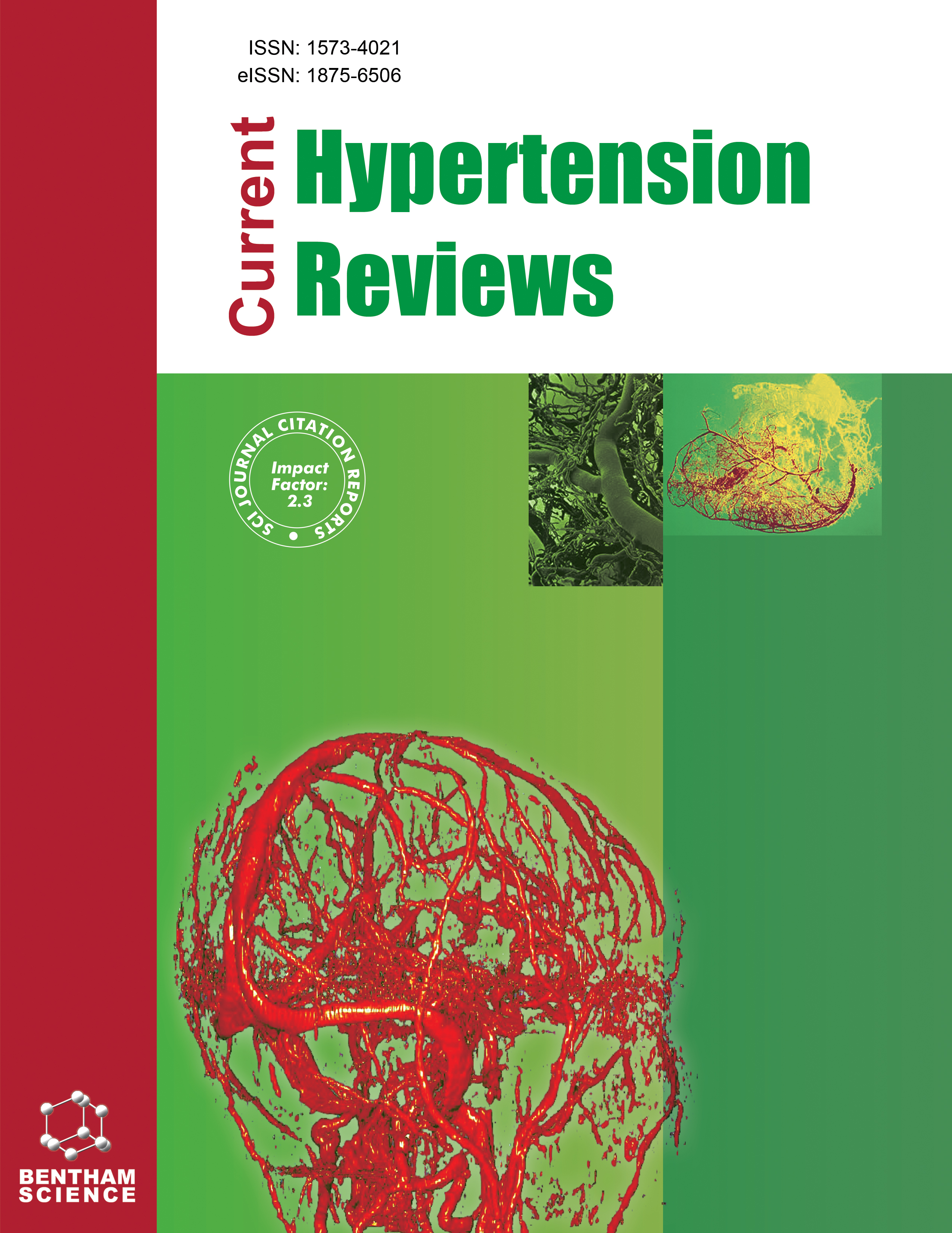- Home
- A-Z Publications
- Current Hypertension Reviews
- Previous Issues
- Volume 2, Issue 3, 2006
Current Hypertension Reviews - Volume 2, Issue 3, 2006
Volume 2, Issue 3, 2006
-
-
Barker and Brenner: A Basis for Hypertension?
More LessAuthors: Karen M. Moritz and John F. BertramIn the large majority of cases, the underlying cause of hypertension is unknown. In the late 1980’s, Barry Brenner and colleagues suggested that individuals with a reduced nephron endowment were more likely to develop hypertension. This was followed soon after by the report from epidemiologist, David Barker and co-workers, of a link between low birth weight and an increased risk of adult cardiovascular disease, in Read More
-
-
-
Regressing Left Ventricular Hypertrophy: The Role of Telmisartan and Other ARBs
More LessLeft ventricular hypertrophy (LVH) is a common form of target organ damage associated with hypertension that increases the risk for cardiovascular morbidity and mortality. Regression of left ventricular mass (LVM) substantially reduces this risk, and antihypertensive treatment is associated with reduction in LVM. Identifying the optimal therapeutic strategy that brings effective BP reductions and superior LVM regre Read More
-
-
-
Neurotransmission Alterations in Central Cardiovascular Control in Experimental Hypertension
More LessAuthors: Ruy Ribeiro de Campos and Cassia T. BergamaschiThe brain pathways involved in the control of arterial blood pressure and sympathetic nerve activity are distributed throughout the central nervous system and are organized in topographically selective ensembles of premotor neurons. There is increasing evidence to support the notion that increased sympathetic nerve activity plays an important role in the pathogenesis of human and experimental hypertension. In this revie Read More
-
-
-
Obesity-Associated Hypertension in Childhood: A New Epidemic Problem
More LessAuthors: Simonetta Genovesi and Federico PieruzziIn recent years, opinions on hypertension in the paediatric age range have been changing. Although secondary forms of childhood hypertension maintain important clinical relevance, lately much more attention has been paid to primary forms of high blood pressure in children. At present, the prevalence of primary hypertension in children is not easily defined, also because of an unsatisfactory knowledge of this phenomenon. A Read More
-
-
-
Clinical and Pre-clinical Applications of the Transcendental Meditation Program® in the Prevention and Treatment of Essential Hypertension and Cardiovascular Disease in Youth and Adults
More LessAuthors: Vernon A. Barnes and David M. Orme-JohnsonAcute and chronic environmental and psychosocial stress contributes to the pathogenesis and progression of cardiovascular diseases (CVD). Stress reduction via Transcendental Meditation (TM)® has been shown to lower blood pressure (BP) levels and reduce CVD risk in adults and adolescents. This article reviews recent findings indicating a beneficial BP-lowering impact of TM in hypertensive adults at rest and in pre-hypertensiv Read More
-
-
-
The Renin-Angiotensin System: Emerging Concepts
More LessThe renin-angiotensin system (RAS) is a pivotal regulator of the renal and cardiovascular functions playing an important role in the control of blood pressure and hydroelectrolyte balance. In the past few years the combination of classical physiopharmacological techniques with modern genomics and protein chemistry methods has lead to the identification of important novel components of the RAS: the Angiotensin (Ang) IV bindin Read More
-
-
-
Renal Cytochrome P450-Derived Eicosanoids and Hypertension
More LessThe cytochrome P450 (CYP) monooxygenase system represents a major metabolic pathway of arachidonic acid in the kidney. The primary CYP monooxygenase-derived arachidonic acid metabolites (eicosanoids) in renal tubular and vascular tissues are hydroxyeicosatetraenoic acids (HETEs) and epoxyeicosatrienoic acids (EETs), which are further metabolized by epoxide hydrolase to dihydroxyeicosatrienoic acids (DHETs). CYP- Read More
-
-
-
Relationship Between Hypertension and Atherosclerosis: From a Viewpoint of the Most Potent Vasoconstrictor Human Urotensin II
More LessAuthors: Takuya Watanabe, Tomoko Kanome and Akira MiyazakiHuman urotensin II (U-II), the most potent vasoconstrictor peptide identified to date, and its receptor (UT) are involved in etiology of hypertension. In hypertensive patients, U-II induces vasoconstriction in forearm brachial artery infusion studies. Recent studies demonstrated elevated plasma U-II concentrations in patients with hypertension, diabetes mellitus, atherosclerosis, and coronary artery disease. U-II is expressed in endot Read More
-
-
-
D3 Dopamine Receptor and Essential Hypertension
More LessAuthors: Chunyu Zeng, Gilbert M. Eisner, Robin A. Felder and Pedro A. JoseDopamine receptors are expressed in a number of organs and tissues; the peripheral dopamine receptors influence cardiovascular and renal function by decreasing preload and afterload and by regulating fluid and electrolyte transport. Most of the knowledge on these actions of dopamine has been garnered from studies of D1-like dopamine receptors. The D3 dopamine receptor subtype, which belongs to the D2-like recept Read More
-
Volumes & issues
-
Volume 21 (2025)
-
Volume 20 (2024)
-
Volume 19 (2023)
-
Volume 18 (2022)
-
Volume 17 (2021)
-
Volume 16 (2020)
-
Volume 15 (2019)
-
Volume 14 (2018)
-
Volume 13 (2017)
-
Volume 12 (2016)
-
Volume 11 (2015)
-
Volume 10 (2014)
-
Volume 9 (2013)
-
Volume 8 (2012)
-
Volume 7 (2011)
-
Volume 6 (2010)
-
Volume 5 (2009)
-
Volume 4 (2008)
-
Volume 3 (2007)
-
Volume 2 (2006)
-
Volume 1 (2005)
Most Read This Month
Article
content/journals/chyr
Journal
10
5
false
en


